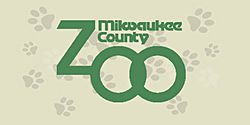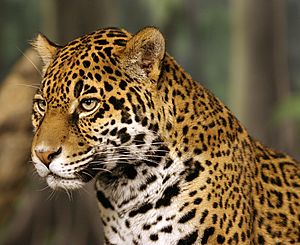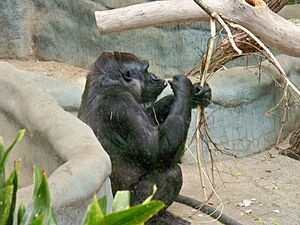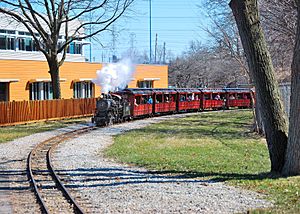Milwaukee County Zoo facts for kids
 |
|
| Date opened | January 16, 1892 (Washington Park site) May 13, 1961 (current site) |
|---|---|
| Location | 10001 W. Bluemound Rd. Milwaukee, Wisconsin |
| Land area | 200 acres (81 ha) |
| Coordinates | 43°1′57.5724″N 88°2′14.64″W / 43.032659000°N 88.0374000°W |
| No. of animals | 3,300 (March 2017) |
| No. of species | 377 (March 2017) |
| Major exhibits | Aviary Apes of Africa/Primates of the World Aquatic and Reptile Center Small Mammal Building Large Mammals Northwestern Mutual Family Farm |
The Milwaukee County Zoo is a fun place to visit in Milwaukee, Wisconsin. It is home to about 1,800 animals and covers a huge area of 190 acres (77 hectares). This zoo is famous for some special animal births. It was one of the first zoos to have polar bear cubs and siamang babies born in captivity.
You might also hear about Samson, a very famous gorilla who lived here from 1950 to 1981. His bones are now at the Milwaukee Public Museum. During World War II, a duck named Gertie and her ducklings became well-known at the zoo. The zoo also has one of the largest groups of bonobos outside their home in the Democratic Republic of the Congo. Plus, you can see two amazing cheetahs from the National Zoo in Washington, D.C.
Contents
- Zoo History: How It Started
- Amazing Animal Exhibits
- Taylor Family Humboldt Penguin Pool
- Herb and Nada Mahler Family Aviary
- Sterns Family Apes of Africa
- Primates of the World
- Macaque Island
- Aquatic and Reptile Center
- Small Mammal Building
- North America
- Northwestern Mutual Family Farm
- Africa/Asia/South America Mixed Exhibits
- Adventure Africa
- Florence Mila Borchert Big Cat Country
- Otter Passage
- Otto Borchert Family Special Exhibits Gallery
- Other Fun Things to Do
- Images for kids
Zoo History: How It Started
The Early Days: Washington Park Zoo
The zoo first opened in 1892 as the West Park Zoo. It started with a small collection of mammals and birds. The next year, two cinnamon bears joined the zoo, and a special iron den was built for them. In 1899, a new building was made for plant-eating animals.
In 1900, the West Park Zoo changed its name to the Washington Park Zoo. Two years later, the zoo grew to 23 acres (9.3 hectares). Even during the Great Depression in the 1930s, the zoo did well. They built a bear den that looked like a natural home for bears. By 1931, the zoo had 37 different bears! In 1942, a reptile exhibit opened. George Speidel, the zoo director then, started planning for a brand new zoo.
Building the Milwaukee County Zoo
Even though it was still in Washington Park, the zoo changed its name again in 1953. It became the Milwaukee County Zoological Gardens. People started raising money in 1956 to help build the new zoo. It was expected to cost about $12.6 million.
The new Milwaukee County Zoo officially opened in 1958. It had a primate building, monkey island, a feline house, and a grizzly bear den. A miniature train, called the Zoo Line, also started running. It took visitors around to see the animals and the new buildings. This train, now called the Safari Train, still runs today with real steam engines!
In 1959, construction began on the dall sheep mountain and the Alaskan bear exhibit. On May 13, 1961, the Milwaukee County Zoo fully opened to everyone. More new areas were added over the years. These included the aviary (1962), the Australian building (1963), and the animal hospital (1963). The small mammal building (1965), the aquarium (1968), and the reptile building (1968) also opened.
In 1965, four Zoomobile tour trains were given to the zoo. The children's zoo opened in 1971. In 1986, a special underwater viewing area for polar bears was added. The children's zoo was renamed the Stackner Heritage Farm that same year. A dairy farm area was built to celebrate Wisconsin as "America's Dairyland." This area had a cow barn, an education center, and a dairy store.
In 1988, the Taylor Family Humboldt penguin exhibit opened. A new education center and the Peck Welcome Center also opened. Later, the sea lion exhibit was updated with underwater viewing. The aviary was also renovated. More recent changes include the Sterns Family Apes of Africa exhibit (1992). The aquarium and reptile building was updated and renamed the Aquatic and Reptile Center. The small mammal building was renovated in 1998. The Wong Family Pheasantry was also added in 1998.
In 2002, Monkey Island was updated and renamed Macaque Island. It got a big deck for visitors to watch the monkeys. A new animal health center opened in 2003. A new education center opened in 2004. In 2005 and 2006, the Heritage Farm, feline building, and giraffe exhibit were all remodeled. The zoo's newest plan includes a new West Entrance with a gift shop. There will also be a new North American river otter exhibit. A new parking lot is also being built.
Amazing Animal Exhibits
Taylor Family Humboldt Penguin Pool
This cool exhibit is near the zoo's main entrance. It has a 15,000-gallon tank where you can see Humboldt penguins swimming. There's a glass wall so you can watch them underwater!
Herb and Nada Mahler Family Aviary
The aviary is a walk-through building with over 60 kinds of birds. One part is a special room where birds fly freely around you! You might see Caribbean flamingos, scarlet ibis, rhinoceros hornbills, and King vultures. There are also Rockhopper penguins, Gentoo penguins, and many other colorful birds.
Sterns Family Apes of Africa
This indoor building is home to a large group of bonobos and gorillas. For many years, Samson, a very large gorilla, lived here. The zoo has a special program to help bonobos have babies. It has one of the biggest collections of bonobos in zoos around the world. Both the bonobos and gorillas have access to indoor and outdoor areas.
Primates of the World
Right next to Apes of Africa, this exhibit shows primates from all over the globe. You can see Mandrills, Sumatran orangutans, Siamangs, and Black-and-white colobus monkeys. There are also Black-handed Spider monkeys. The zoo was one of the first places where a Siamang was born in a zoo.
Macaque Island
Macaque Island is home to a group of Japanese macaques. It's a big mountain surrounded by water. It was updated in 2002 to have a large viewing deck for visitors. The macaques also got a bigger shelter with waterfalls.
Aquatic and Reptile Center
This building is full of amazing creatures that live in water or are reptiles and amphibians. You can see invertebrates, fish, reptiles, and amphibians. Some cool animals here include the Chinese alligator, Green anaconda, Mexican beaded lizard, and King cobra. There are also different kinds of Cichlid fish, Rockfish, and a huge Giant Pacific octopus.
Small Mammal Building
This building is near the Aquatic and Reptile Center. It has a special room for animals that are active at night. This room is dark during the day and bright at night. This helps the animals stay on a schedule that works for zoo visitors. You can see Fennec foxes, sugar gliders, vampire bats, and ring-tailed lemurs. Other animals include Springhaas, dwarf mongoose, and Two-toed sloths.
North America
This area has outdoor exhibits that look like the wild lands of North America. You'll find large animals like bears and deer. This includes grizzly bears, Alaskan brown bears, and polar bears. You can also see American elk, trumpeter swans, harbor seals, and prairie dogs. Many animals are in "panorama" exhibits. This makes it look like predators and prey are in the same space, but hidden moats keep them safe.
Northwestern Mutual Family Farm
This is the updated children's zoo. It focuses on animals native to the Midwest United States. You can learn about animals like the hedgehog, domestic duck, North American porcupine, and Florida box turtle. You might also see a red-tailed hawk and a bald eagle. This farm replaced the Stackner Heritage Farm in 2005. The Northwestern Mutual Family Farm also has many farm animals. These include Ayrshire cattle, Guinea Hogs, Sicilian Donkeys, and Holstein Cows. You can also see chickens, goats, rabbits, and Horses.
Africa/Asia/South America Mixed Exhibits

This area has outdoor exhibits with animals from three different continents. Some exhibits are "panorama" style, making it seem like different animals share the same space. Much of this area is becoming a new project called Adventure Africa. Many exhibits here are for animals from the African savannah. You can see plains zebras, waterbucks, and common elands.
From South America, you might see greater rheas, Baird's tapirs, and alpacas. There's also an outdoor yard for the jaguar. Asian animals include the Amur tiger and Bactrian camel. The Giraffe House was updated in 2006. Now, visitors can go up a deck and get face-to-face with the zoo's reticulated giraffes. You can even feed them! This giraffe exhibit will stay the same in the Adventure Africa area. Later, impalas and Thomson's gazelles were added to the zoo's African animal collection.
Adventure Africa
Adventure Africa opened in the spring of 2019. It is the new home for more than seven animal species. Four of these animals moved from their old exhibits. The new Elephant Care Center is a warm indoor home for African bush elephants. It's also a place for zoo classes and events. The elephants also have a big outdoor area, about 1.6 acres. It has a large watering hole and special walls for feeding. Heaters in the yard let the elephants use the space even when it's cold.
Impala Plains is one of two mixed exhibits in Adventure Africa. It has impalas, plains zebras, ostriches, and grey crowned cranes. Another exhibit, the African Forest, is home to eastern bongos, guinea fowl, and yellow-backed duikers. Future plans for Adventure Africa include a new exhibit for hippopotamuses. The old elephant exhibit will become a new home for the zoo's black rhinos.
Florence Mila Borchert Big Cat Country
This large indoor Big Cat exhibit was updated in 2005. It now has bigger indoor and outdoor homes for the zoo's main cat collection. You can see African lions, Amur tigers, snow leopards, and jaguars. There's also a new home for the zoo's red pandas. Plus, you can see new exhibits for cheetahs, servals, and caracals.
Otter Passage
Opened in spring 2018, the Otter Passage is home to a group of North American river otters. They have a large exhibit with two pools for underwater viewing. This exhibit opened with the new West Entrance. It's like the Taylor Family Humboldt Penguin Pool, welcoming visitors as they enter the zoo.
Otto Borchert Family Special Exhibits Gallery
This building is used for special or traveling exhibits that visit the zoo.
Other Fun Things to Do
Safari Train
The 15-inch gauge miniature railway first opened in 1958. It still takes guests around the zoo from Memorial Day through Labor Day. The railroad started with a steam locomotive named #82. It was built in 1957. Later, a diesel locomotive #1958 joined the fleet. Two more steam locomotives, #1916 and #1924, were added. The #82 train was later put on display because it was too small for the large crowds.
Kid-Friendly Areas
- Playground
- Treehouse area
- Dinosaur exhibit (open during certain seasons)
- Sky Trail® Ropes Courses & Zip Line
- Ski Safari
- Zoo Mobile
Images for kids




